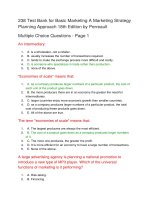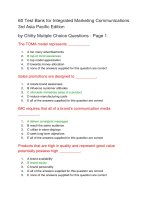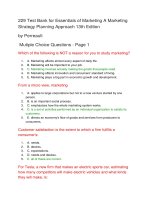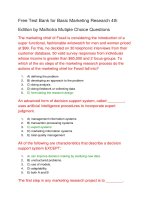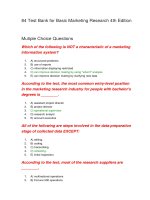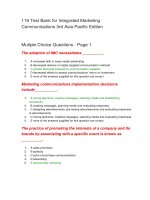238 test bank for basic marketing a marketing strategy planning approach 18th edition by perreault
Bạn đang xem bản rút gọn của tài liệu. Xem và tải ngay bản đầy đủ của tài liệu tại đây (276.73 KB, 59 trang )
238 Test Bank for Basic Marketing A Marketing Strategy
Planning Approach 18th Edition by Perreault
Multiple Choice Questions - Page 1
An intermediary:
1.
A. is a wholesaler--not a retailer.
2.
B. usually increases the number of transactions required.
3.
C. tends to make the exchange process more difficult and costly.
4.
D. is someone who specializes in trade rather than production.
5.
E. none of the above.
"Economies of scale" means that:
1.
A. as a company produces larger numbers of a particular product, the cost of
each unit of the product goes down.
2.
B. the more producers there are in an economy the greater the need for
intermediaries.
3.
C. larger countries enjoy more economic growth than smaller countries.
4.
5.
D. as a company produces larger numbers of a particular product, the total
cost of producing these products goes down.
E. All of the above are true.
The term "economies of scale" means that:
1.
2.
A. The largest producers are always the most efficient.
B. The cost of a product goes down as a company produces larger numbers
of it.
3.
C. The more one produces, the greater the profit.
4.
D. It is more efficient for an economy to have a large number of transactions.
5.
E. None of the above.
A large advertising agency is planning a national promotion to
introduce a new type of MP3 player. Which of the universal
functions of marketing is it performing?
1.
A. Risk-taking.
2.
B. Financing.
3.
C. Buying.
4.
D. Selling.
5.
E. None of the above.
Collaborators
1.
A. specialize in trade rather than production.
2.
B. usually have a production orientation.
3.
C. emerged in the marketing company era.
4.
D. are only used in a command economy.
5.
E. facilitate or provide one or more of the marketing functions other than
buying or selling.
Amazon.com and eBay.com are both considered
1.
A. Internet-based collaborators.
2.
B. Internet-based producers.
3.
C. Internet-based service providers.
4.
D. Internet-based intermediaries.
5.
E. Internet-based manufacturers.
Which of the universal functions of marketing deals most directly
with advertising a product in magazines?
1.
A. Transporting
2.
B. Selling
3.
C. Financing
4.
D. Risk-taking
5.
E. Market information
Marketing intermediaries and collaborators can often perform
marketing functions:
1.
A. better than producers or consumers can perform them.
2.
B. which leaves producers and consumers more time for production and
consumption.
3.
C. at a low cost--because of specialization, economies of scale, or ecommerce.
4.
D. all of the above are true.
5.
E. none of the above are true.
Which of the following statements about the "universal functions of
marketing" is False?
1.
A. These functions do not have to be performed in all macro-marketing
systems.
2.
B. How the functions are performed may differ among nations and economic
systems.
3.
C. Who performs the functions may differ among nations and economic
systems.
4.
D. These functions help to overcome discrepancies of quantity and
assortment.
5.
E. None of the above.
Which of the following is LEAST likely to be classified as a
marketing collaborator?
1.
A. United Parcel Service (UPS).
2.
B. Public Warehouse Corporation.
3.
C. Broadband Communications Company.
4.
D. MeadowView Aluminum Company.
5.
E. Product Safety Testing Laboratories, Inc.
______________ involve(s) sorting products according to size and
quality.
1.
A. Transporting and storing
2.
B. Financing
3.
C. Standardization and grading
4.
D. Marketing
5.
E. Buying
Which of the following is MOST likely to be classified as a
marketing intermediary?
1.
A. Apex Manufacturing, Inc.
2.
B. Lillian's Mini-Market.
3.
C. McGraw Hill/Irwin.
4.
D. Kellogg.
Firms that specialize in providing marketing functions other than
buying and selling are known as:
1.
A. suppliers.
2.
B. intermediaries.
3.
C. advisors.
4.
D. collaborators.
5.
E. agents.
The buying function of marketing involves
1.
A. risk-taking.
2.
B. promoting the product.
3.
C. looking for and evaluating goods and services.
4.
D. the use of personal selling.
5.
E. sorting products according to size and quality.
Considering the universal functions of marketing,
1.
A. they may not be required in all macro-marketing systems.
2.
B. not every firm must perform all of the marketing functions.
3.
C. all goods and services require all the functions at every level of their
production.
4.
D. all of the above are true.
5.
E. none of the above is true.
Concerning the "universal functions of marketing," which of the
following statements is FALSE?
1.
A. These functions can be performed by producers, intermediaries,
collaborators, or consumers.
2.
B. Responsibility for performing these functions can be shared and shifted.
3.
C. From a micro viewpoint, not every company must perform every function.
4.
5.
D. From a macro viewpoint, all these functions must be performed by
someone.
E. None of the above is false.
The "universal functions of marketing" can be performed by:
1.
A. producers.
2.
B. intermediaries and collaborators.
3.
C. consumers.
4.
D. All of the above.
5.
E. Only A and C above.
Discrepancies of assortment happen when
1.
A. producers prefer to produce and sell in large numbers, but consumers
prefer to buy and consume in smaller numbers.
2.
B. consumers may not want to consume goods and services at the time
producers would prefer to produce them.
3.
C. consumers value goods and services in terms of costs and competitive
prices whereas producers value them in terms of satisfying needs and ability to
pay.
4.
D. producers specialize in producing a narrow range of goods and services
but consumers need a wide variety.
5.
E. producers hold title to goods and services that they themselves do not want
to consume.
The "universal functions of marketing":
1.
A. are usually performed in the same way and by the same types of
institutions in all MACRO-marketing systems.
2.
B. can sometimes be eliminated--in very efficient macro-marketing systems.
3.
C. must be performed in both market-directed and command economies.
4.
D. must all be performed by every firm from a MICRO view.
5.
E. All of the above are true.
The universal functions of marketing include buying, selling,
transporting, storing,
__________________________________________.
1.
A. standardization and weighing, financing, risk taking, and marketing
information
2.
B. standardization and grading, facilitating, risk taking, and marketing
information
3.
C. standardization and grading, financing, risk taking, and marketing
information
4.
D. standardization and grading, financing, risk taking, and merchandising
information
When a firm produces a large quantity of a product, the cost of
producing each individual unit usually goes down. This is known
as:
1.
A. discrepancies of quantity.
2.
B. exchange efficiency.
3.
C. economies of scale.
4.
D. macro-marketing.
5.
E. discrepancies of assortment.
The standardization and grading function of marketing involves:
1.
A. Looking for and evaluating goods and services.
2.
B. Providing necessary cash and credit.
3.
C. Promoting the product.
4.
D. Sorting products according to size and quality.
5.
E. None of the above.
Market research firm BestOne sells reports about competitors,
products, and other areas to various clients in the software industry.
BestOne performs which universal marketing function:
1.
A. risk taking.
2.
B. market information.
3.
C. standardization and grading.
4.
D. social responsibility.
5.
E. financing.
The standardization and grading function of marketing involves:
1.
A. promoting goods and services.
2.
B. collection, analysis, and distribution of marketing information.
3.
C. sorting products according to size and quality.
4.
D. looking for and evaluating goods and services.
5.
E. movement of goods from one place to another.
Which of the following is a true statement?
1.
A. Since marketing is concerned with many thousands of different products,
there is no one set of marketing functions that applies to all products.
2.
B. Responsibility for performing marketing functions can be shifted and
shared, but no function can be completely eliminated.
3.
C. From a micro viewpoint, every firm must perform all of the marketing
functions.
4.
D. Marketing functions should be performed only by marketing intermediaries
or collaborators.
5.
E. Many marketing functions are not necessary in market-directed economies.
The "universal functions of marketing":
1.
A. can be eliminated in advanced MACRO-marketing systems.
2.
B. are performed differently and by different parties in different economies.
3.
C. are never performed by consumers.
4.
5.
D. create various separations and discrepancies between producers and
consumers.
E. All of the above are true.
In macro-marketing
1.
A. no universal marketing function can be completely eliminated.
2.
B. the objectives of the individual firm, rather than society, are most important.
3.
C. functions should not be shifted or shared.
4.
D. intermediaries are unnecessary.
5.
E. the emphasis is on the activities of individual organizations.
Which of the following is LEAST likely to be classified as a
marketing collaborator?
1.
A. Mayflower Transport Company.
2.
B. Internet Advertising, Inc.
3.
C. Wachovia Bank.
4.
D. Market Survey Research, Inc.
5.
E. Quality Coatings Company.
Which of the following is NOT true about intermediaries?
1.
A. They save time for other participants in a transaction.
2.
B. They always increase total expenses for a product.
3.
C. They specialize in trade rather than production.
4.
D. All of the above.
5.
E. None of the above.
The "universal functions of marketing" do NOT include:
1.
A. financing and risk taking.
2.
B. standardization and grading.
3.
C. producing.
4.
D. transporting and storing.
5.
E. buying and selling.
After seeing a "sale" ad in a local newspaper, Ben Griffith went to a
local pet supply store and bought a year's supply of high protein
dog food. Which marketing functions--if any--did he perform?
1.
A. Financing and risk taking
2.
B. Buying, transporting, and storing
3.
C. Market information
4.
5.
D. All of the above
E. None of the above--only producers and intermediaries perform marketing
functions.
Which of the following types of firms are collaborators?
1.
A. Marketing research firms
2.
B. Overnight delivery firms
3.
C. Advertising agencies
4.
D. Product-testing labs
5.
E. All of the above
Firms that specialize in providing marketing functions other than
buying or selling are known as:
1.
A. suppliers.
2.
B. intermediaries.
3.
C. consultants.
4.
D. agents.
5.
E. collaborators.
_______ refers to producers holding title to goods and services that
they themselves do not want to consume and consumers wanting
goods and services that they do not have.
1.
A. Discrepancies of assortment
2.
B. Separation of ownership
3.
C. Discrepancies of quantity
4.
D. Spatial separation
5.
E. Separation in time
Which of the following is NOT one of the "universal functions of
marketing"?
1.
A. Production
2.
B. Standardization
3.
C. Financing
4.
D. Buying
5.
E. Transporting
The universal functions of marketing
1.
A. are not all needed in market-directed economies.
2.
B. are not all needed in command economies.
3.
C. can be performed by producers, consumers, and a variety of marketing
specialists.
4.
D. All of the above are true.
5.
E. None of the above is true.
The "universal functions of marketing":
1.
A. must be performed in all MACRO-marketing systems.
2.
B. are performed differently in different economies.
3.
C. are performed by different parties in different economies.
4.
D. are needed to help overcome various separations and discrepancies.
5.
E. All of the above are true.
The advantages of working with an intermediary usually increase
when there is
1.
A. difficulty communicating with customers.
2.
B. a greater number of customers.
3.
C. greater distance between customers.
4.
D. a larger number of competing products.
5.
E. all of the above.
238 Free Test Bank for Basic Marketing A Marketing
Strategy Planning Approach 18th Edition by Perreault
Multiple Choice Questions - Page 2
Which of the following must occur for marketing to happen?
1.
A. Product
2.
B. Place
3.
C. Advertising
4.
D. Price
5.
E. Two or more parties exchange something of value for something else of
value.
In advanced economies:
1.
A. mass production with its economies of scale makes the cost of each
product higher.
2.
B. exchange is simplified by discrepancies of quantity and assortment.
3.
C. there is little need for marketing specialists.
4.
D. both supply and demand tend to be homogeneous in nature.
5.
E. producers and consumers experience a separation of values.
In a pure subsistence economy,
1.
A. each family unit is self-sufficient.
2.
B. exchanges are not important.
3.
C. there is no need for intermediaries.
4.
D. All of the above are true.
5.
E. None of the above is true.
Looking at marketing as a social process focuses on
1.
A. macro-marketing.
2.
B. for-profit marketing.
3.
C. micro-marketing.
4.
D. nonprofit marketing.
5.
E. personalized marketing.
Exchange between producers and consumers is more difficult in an
advanced economy because of:
1.
A. separation in time.
2.
B. separation in values.
3.
C. spatial separation.
4.
D. separation of information.
5.
E. All of the above.
Which of the following statements about marketing is FALSE?
1.
A. Marketing affects the products you buy.
2.
B. Marketing applies to nonprofit organizations too.
3.
C. Marketing affects the advertising you see and hear.
4.
D. Marketing offers many good job opportunities.
5.
E. Marketing can help with individual transactions but not in building
relationships with customers.
Marketing could NOT take place without:
1.
A. intermediaries.
2.
B. collaborators.
3.
C. two or more parties who are willing to exchange something for something
else.
4.
D. a high standard of living.
5.
E. all of the above.
The following headlines are from Business Week magazine. Which
article is most likely to be reporting on a MACRO-marketing topic?
1.
A. "Two-Person Engineering Firm Offers Unique Service."
2.
B. "Russia Increases Output of Consumer Goods."
3.
C. "Pepsi Sells in Japan."
4.
D. "Bank of America Offers New Internet Banking Services."
5.
E. "Donations to Tsunami Victims Fund Increase after TV Broadcast."
The fact that US car companies are located in the upper Midwest
while their customers are located throughout the U.S. is an example
of:
1.
A. separation in values.
2.
B. discrepancies of assortment.
3.
C. separation of information.
4.
D. spatial separation.
5.
E. separation in time.
The following headlines are for articles from the WALL STREET
JOURNAL. Which article is most likely to be reporting a MACROmarketing topic?
1.
A. "Mercedes Goes after Luxury Sport Utility Buyers."
2.
B. "Adidas Jumps as Footwear Competition Heats Up."
3.
C. "Drugstore Chain Aims at Seniors."
4.
D. "Hardee's Fried Chicken Takes on KFC."
5.
E. "DVD Popularity Leads to More DVD Retailers."
Societies need a macro-marketing system
1.
A. to help match supply and demand.
2.
B. to create a gap between producers and consumers.
3.
C. to accomplish an organization's objectives only.
4.
D. to identify collaborators.
5.
E. to reduce the need for intermediaries.
Of the following headlines from a business magazine, which is most
likely to be about a MACRO-marketing topic?
1.
A. "Chinese Women Demand More Luxury Goods."
2.
B. "Girl Scouts Organize Nationwide Cookie Sale."
3.
C. "L'eggs Sells Direct in Brazil and Argentina."
4.
D. "Frito-Lay Offers New Low-Fat Products."
5.
E. "Coke Losing Beverage Sales in India to local brands."
When an individual producer sets a price for its product to earn a
certain profit while consumers search for the product at the lowest
price available from any producer, this is an example of:
1.
A. separation in time.
2.
B. discrepancy of quantity.
3.
C. separation in values.
4.
D. discrepancy of assortment.
5.
E. spatial separation.
In advanced economies:
1.
A. both supply and demand tend to be heterogeneous.
2.
B. producers and consumers are often separated in several ways.
3.
C. exchange is hampered by discrepancies of quantity and assortment.
4.
D. All of the above are true.
5.
E. None of the above is true.
Macro-marketing
1.
A. emphasizes building a long-term relationship that benefits both the firm and
the customer.
2.
B. considers the marketing activities of corporations rather than individuals.
3.
C. emphasizes how the whole marketing system works.
4.
D. systems are only relevant to advanced economies.
5.
E. addresses discrepancies that emerge from homogeneous consumer
demand.
If the family units on a South Pacific-island nation made all the
products they consume, it would be a good example of:
1.
A. a pure subsistence economy.
2.
B. a market-directed economy.
3.
C. a micro-marketing system.
4.
D. a command economy.
5.
E. none of the above.
The primary purpose of the transporting and storing functions of
marketing is to overcome:
1.
A. the need for marketing specialists.
2.
B. separation of information.
3.
C. spatial separation.
4.
D. discrepancies of assortment.
5.
E. separation of values.
Marketing will not happen unless:
1.
A. e-commerce is flourishing.
2.
B. collaborators are present to simplify exchange.
3.
4.
5.
C. intermediaries are present to facilitate exchange.
D. two or more parties each have something they want to exchange for
something else.
E. an economy is market-directed rather than command.
Macro-marketing
1.
A. is a social process.
2.
B. concerns the activities of individual managers.
3.
C. is what people have in mind when they talk about marketing in everyday
use.
4.
D. helps consumers that need a narrow assortment of products.
5.
E. applies only to nonprofit organizations.
Macro-marketing:
1.
A. is not concerned with the flow of goods and services from producers to
consumers.
2.
B. seeks to match homogeneous supply capabilities with homogeneous
demands for goods and services.
3.
C. refers to a set of activities performed by both profit and nonprofit
organizations.
4.
D. focuses on the objectives of society.
5.
E. All of the above are true statements.
(p. 8-9) Of the following headlines from the WALL STREET
JOURNAL, which is most likely to be about a MACRO-marketing
topic?
1.
A. "Tupperware Has a New Strategy."
2.
B. "Thailand Has Unusually Large Number of Wholesalers."
3.
C. "Military Supplier Shifts to Selling Gas Masks to Private Citizens."
4.
D. "Coke Plans Beverage Line to Compete with Lipton's."
5.
E. "Dow Chemical Adds Shipping Safeguards."
Macro-marketing:
1.
A. tries to produce discrepancies of quantity and discrepancies of assortment.
2.
B. focuses on the activities of individual organizations.
3.
C. tries to effectively match supply and demand.
4.
D. all of the above.
5.
E. none of the above.
Marketing is NOT needed in a ______________ economy.
1.
A. consumer-oriented
2.
B. command
3.
C. pure subsistence
4.
D. market-directed
5.
E. none of the above
Which of the following statements is FALSE?
1.
2.
3.
4.
5.
A. Marketing is most important in a pure subsistence economy.
B. Marketing should provide direction for production, accounting, and financial
activities.
C. Marketing builds long-lasting relationships that benefit the selling firm.
D. Marketing doesn't occur unless two or more parties are willing to exchange
something for something else.
E. Marketing anticipates customer needs.
American supermarket chain, FoodMart, purchases cheese from
five different manufacturers from around the world to assure its
customers can choose among different types of cheeses at different
prices. FoodMart facilitates the macro-marketing system by helping
to address:
1.
A. spatial separation.
2.
B. discrepancies of assortment.
3.
C. separation of values.
4.
D. all of the above.
5.
E. none of the above.
Viewing marketing as a social process focuses on
1.
A. marketing by nonprofit organizations.
2.
B. command economies.
3.
C. macro-marketing.
4.
D. micro-marketing.
5.
E. none of the above.
When consumers do not know where to buy a product or what it
costs and the product's producer does not know where its target
market is located, this is an example of:
1.
A. separation of information.
2.
B. discrepancy of quantity.
3.
C. separation of ownership.
4.
D. discrepancy of assortment.
5.
E. separation in time.
In a simple economy, one family may produce only cooking pots,
but many of them. Others may specialize in farming, making
clothing, and building shelters. This ....
1.
A. shows why "discrepancies of assortment" occur.
2.
B. is so simple that the universal functions of marketing don't have to be done.
3.
C. cannot work without an intermediary.
4.
5.
D. is an example of "separation in values" since the different families choose
to produce different things.
E. All of the above are true.
MACRO-marketing:
1.
A. is concerned with the activities performed by individual business
organizations.
2.
B. tries to match heterogeneous supply capabilities with heterogeneous
demands for goods and services.
3.
C. is concerned with how effectively and fairly an individual business
organization performs.
4.
D. assumes that the effectiveness and fairness of all macro-marketing
systems must be evaluated in terms of the same social objectives.
5.
E. All of the above are true.
MACRO-marketing:
1.
2.
3.
4.
5.
A. is a social process.
B. tries to overcome "discrepancies of quantity" and "discrepancies of
assortment."
C. tries to effectively match supply and demand.
D. tries to overcome the many separations between producers and
consumers.
E. All of the above are true statements.
MACRO-marketing:
1.
2.
A. Emphasizes how the whole marketing system works.
B. Considers how marketing affects society, but not how society affects
marketing.
3.
C. Matches homogeneous supply and demand.
4.
D. Is mainly concerned with the activities of individual organizations.
5.
E. All of the above.
The fact that producers usually prefer to produce products in large
quantities, while most consumers prefer to buy in small quantities,
results in:
1.
A. discrepancies of quantity.
2.
B. separation of ownership.
3.
C. discrepancies of assortment.
4.
D. spatial separation.
5.
E. temporal separation.
_________ directs an economy's flow of goods and services from
producers to consumers in a way that effectively matches supply
and demand and accomplishes the society's objectives.
1.
A. Macro-marketing
2.
B. The transporting function
3.
C. Micro-marketing
4.
D. Standardization and grading
5.
E. Social responsibility
238 Free Test Bank for Basic Marketing A Marketing
Strategy Planning Approach 18th Edition by Perreault
Multiple Choice Questions - Page 3
Marketing:
1.
A. is concerned with whether the whole system is fair and effective.
2.
B. applies only to profit organizations.
3.
C. consists only of personal selling and advertising.
4.
D. is a social process.
5.
E. tries to anticipate and satisfy customer needs and accomplish an
organization's objectives.
Marketing can be viewed as:
1.
A. a set of activities performed by individual organizations.
2.
B. relevant to both business and nonprofit organizations.
3.
C. a social process.
4.
D. all of the above are correct.
5.
E. only A and B above.
The text stresses that:
1.
2.
3.
4.
5.
A. advertising and selling are not really part of marketing.
B. marketing is nothing more than a set of business activities performed by
individual firms.
C. marketing techniques have no application for nonprofit organizations.
D. marketing is a social process and a set of activities performed by
organizations.
E. a good product usually sells itself.
According to the text, marketing means:
1.
A. much more than selling and advertising.
2.
B. selling.
3.
C. producing and selling.
4.
D. advertising.
5.
E. selling and advertising.
All of the following should be determined by the marketing
department of a firm EXCEPT:
1.
A. storing the product.
2.
B. actually making the product.
3.
C. advertising the product.
4.
D. designing the packaging for the product.
5.
E. setting the price of the product.
In an advanced economy, marketing costs account for about ___
cents of every consumer dollar.
1.
A. 10
2.
B. 20
3.
C. 30
4.
D. 40
5.
E. 50
Marketing should
1.
A. begin with the production process.
2.
B. make decisions about product design and packaging, prices or fees.
3.
C. not need to coordinate with production, accounting, and financial activities.
4.
D. provide input, but let production determine what goods and services are to
be developed.
5.
E. focus on getting customers to make a final purchase.
Looking at marketing as a set of activities focuses on
1.
A. macro-marketing.
2.
B. for-profit marketing.
3.
C. micro-marketing.
4.
D. nonprofit marketing.
5.
E. personalized marketing.
For Tesla, a new firm that makes an electric sports car, estimating
how many competitors will make electric vehicles and what kinds
they will make, is:
1.
A. one of the universal functions of innovation.
2.
B. a production activity.
3.
C. an example of the micro-macro dilemma.
4.
D. best left to intermediaries.
5.
E. a part of marketing.
Effective marketing should begin with
1.
A. an effort to persuade unwilling customers to buy the firm's products.
2.
B. potential customer needs.
3.
C. a decision about what the firm can produce efficiently.
4.
D. evaluation of the effect of the firm's decisions on the MACRO-marketing
system.
5.
E. the marketing manager making important production, accounting, and
financial decisions for the firm.
From a micro view, marketing
1.
A. applies to large corporations but not to a new venture started by one
person.
2.
B. is an important social process.
3.
C. emphasizes how the whole marketing system works.
4.
D. is a set of activities performed by an individual organization to satisfy its
customers.
5.
E. directs an economy's flow of goods and services from producers to
consumers.
According to the text, marketing means:
1.
A. making a good product that sells itself.
2.
B. much more than selling and advertising.
3.
C. selling and advertising.
4.
D. producing goods and/or services.
5.
E. doing whatever it takes to be able to offer consumers a "better mousetrap."
Which of the following statements about marketing is FALSE?
1.
A. Marketing concepts and techniques apply for nonprofit organizations--as
well as for profit-seeking organizations.
2.
B. Marketing offers many rewarding career opportunities.
3.
C. The cost of marketing is about 15 percent of the consumer's dollar.
4.
D. Marketing affects almost every part of your daily life.
5.
E. Marketing is vital for economic growth and development.
____________________ is the extent to which a firm fulfills a
customer's needs, desires, and expectations
1.
A. Customer forecast
2.
B. Customer satisfaction
3.
C. Customer service
4.
D. Customer support
The aim of marketing is to
1.
A. help create a pure subsistence economy.
2.
B. eliminate the need for exchanges.
3.
C. persuade customers to buy the firm's product.
4.
5.
D. identify customers' needs and meet those needs so well that the product
almost "sells itself."
E. facilitate a single transaction.
Which of the following is NOT a reason for you to study marketing?
1.
A. Marketing affects almost every aspect of daily life.
2.
B. Marketing will be important to your job.
